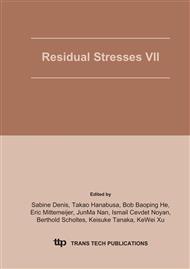p.213
p.218
p.223
p.229
p.234
p.239
p.245
p.251
p.257
Suppression of Surface Effect by Using Bent-Perfect-Crystal Monochromator in Residual Strain Scanning
Abstract:
Using our long experience in Bragg diffraction optics we successfully used focusing principles for substantial increasing both luminosity and resolution of the strain scanners with respect to the conventional devices. Monochromatic neutrons are selected by the cylindrically bent monochromator from the reactor spectrum. There is a strong correlation between divergences of incoming and outgoing beams with respect to the polycrystalline sample, which can be easily manipulated by changing the monochromator bending radius. By setting a proper value of the radius, a narrow, quasiparallel and highly luminous output beam can by adjusted. The strong correlation between wavelength and direction of incoming and outgoing beams depending on the monochromator bending radius can be as well used for suppression of surface effect in residual strain scanning. In scanning near a sample surface aberration peak shifts arise due to the fact that the gauge volume defined by input and output slits is partially out of the sample and its value can be of the same order as the residual strain effects. In this work we demonstrate that by changing of the bending radius of monochromator, this surface effect can be suppressed to values smaller then experimental errors in residual strain scanning.
Info:
Periodical:
Pages:
234-238
Citation:
Online since:
July 2005
Authors:
Price:
Сopyright:
© 2005 Trans Tech Publications Ltd. All Rights Reserved
Share:
Citation:


